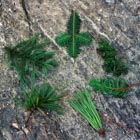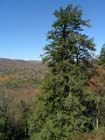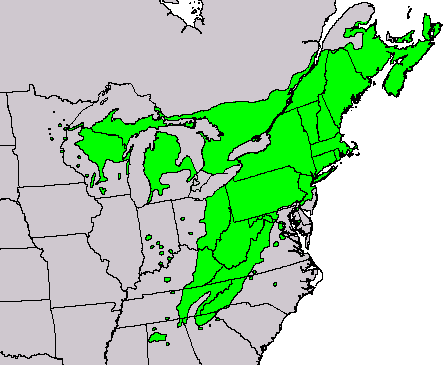Conservation Status

Tsuga canadensis
(L.) Carrière (1855)
Common names
Eastern hemlock, Canada hemlock, pruche du Canada (Taylor 1993), hemlock spruce.
Taxonomic notes
The synonyms include 66 names (see POWO for the full list), but none are in common use; most are formae or varieties applied to horticultural specimens. This is a member of the North American clade of Tsuga, sister to the western species but only distantly related to T. caroliniana with which it sometimes grows (Feng et al. 2021).
Description
Trees to 30 m; trunk to 150 cm dbh; crown broadly conic. Bark brownish, scaly and fissured. Twigs yellow-brown, densely pubescent. Buds ovoid, 1.5-2.5 mm. Leaves (5)15-20(25) mm, mostly appearing 2-ranked, flattened; abaxial surface glaucous, with 2 broad, conspicuous stomatal bands, adaxial surface shiny green (yellow-green); margins minutely dentate, especially toward apex. Seed cones ovoid, 1.5-2.5 × 1-1.5 cm; scales ovate to cuneate, 8-12 × 7-10 mm, apex ± round, often projected outward. 2n=24 (Taylor 1993). See García Esteban et al. (2004) for a detailed characterization of the wood anatomy.
Distribution and Ecology
Canada: New Brunswick, Nova Scotia, Ontario, Prince Edward Island, Québec; USA: Connecticut, Delaware, District of Columbia, Georgia, Indiana, Kentucky, Maine, Maryland, Massachusetts, Michigan, Minnesota, New Hampshire, New Jersey, New York, North Carolina, Ohio, Pennsylvania, Rhode Island, South Carolina, South Dakota, Tennessee, Vermont, Virginia, West Virginia, Wisconsin. Occurs at 600-1800 m elevation on moist rocky ridges, ravines, and hillsides (Taylor 1993). See also Thompson et al. (1999). Hardy to Zone 4 (cold hardiness limit between -34.3°C and -28.9°C) (Bannister and Neuner 2001).
The species is currently experiencing catastrophic range reduction as a result of infestation by the hemlock wooly adelgid, Adelges tsugae. This insect pest, introduced to North America from Asia in 1924, has been responsible for widespread dieback of Tsuga canadensis forests. The adelgid was a relatively minor pest until the mid-1980s, confined to parts of Virginia, Pennsylvania, New Jersey, New York and Connecticut. Thereafter it began rapid range extension and now occurs throughout much of the range of Tsuga canadensis from Georgia to Maine along and east of the Appalachian cordillera (USFS 2007); see also ENTS (2005). As of the early 2020s, significant progress has been made developing biocontrols for the adelgid (primarily, introduced predatory beetles), and the prospects for saving eastern hemlock are now quite good. The biocontrol efforts depend upon the introduction of predatory beetles that are highly adapted to prey solely upon species of adelgid; the most effective introductions so far are beetles native to the Pacific Northwest, which unfortunately are killed by the cold winters experienced in the northern and more continental portions of the range of Tsuga canadensis (Onken and Reardon 2011, Will Blozan pers. comm. 2024.03.08).
Remarkable Specimens
The big tree story for this species is one of death and decline. Each giant tree has successively fallen victim to the hemlock wooly adelgid, and each successive living giant is smaller than the one before. Almost all of the largest and tallest trees that had been identified by about 2007 are now dead. The largest hemlock recorded was located in late April 2007 after it had died; it was located in upper Caldwell Fork, Cataloochee, North Carolina and was 46.94 m tall with an estimated volume of 48.1 m3 (Will Blozan email 2007.05.05). From 2006 to 2009 the largest living hemlock was the Laurel Branch Leviathan, dbh 175 cm, height 46.6 m, stem volume 44.8 m3. See Blozan (2006a) for these data, along with a great story and photos about climbing this giant tree. On June 2, 2009, Blozan revisited this tree and found that it had succumbed to the adelgid despite a concentrated program of efforts to save it by use of an appropriate pesticide treatment (Will Blozan email 2009.06.14). Currently (early 2024) the largest hemlock is the Cheoah Hemlock, discovered by Rusty Rhea, USFS-NC Forest Health Specialist, during an aerial predator beetle release (to combat hemlock woolly adelgid) in the surrounding grove in May 2004 (Blozan 2006b). Will Blozan and Jess Riddle subsequently measured the tree at 155 cm dbh and 48.46 m tall (American Forests 2015). The tree has received considerable media attention and has had multiple treatments for hemlock wooly adelgid, which seems to be keeping it alive (Landfield 2022, Blozan pers. comm. 2024.03.06).
The tallest specimen on record was the Usis Hemlock near Cataloochee, North Carolina, which was 52.8 m tall, but which succumbed to the hemlock wooly adelgid in the summer of 2007 (Will Blozan email 2007.11.01). Blozan (2007) provides the details, along with story and photos about climbing this tree. The tallest known living tree was then thought to be the Noland Mountain hemlock, slightly more than 51.8 m tall (Will Blozan email 2007.11.01), but the tree has not been re-inventoried since 2007 and there is a high probability that it is now dead (Will Blozan email 2024.01.13). In that case, Cheoah (above) is also the tallest confirmed tree (Will Blozan pers. comm. 2024.03.08).
The oldest known tree has a crossdated age of 651 years; it was found in summer 2023 in an old-growth forest in northwestern Pennsylvania. The tree was cored at a 2 m height, so it could be significantly older (Harvard Forest 2023). Prior to this discovery, the oldest known tree was specimen O39021, collected near Tionesta, Pennsylvania by Ed Cook in 1978. The oldest ring on this sample was crossdated to 1425, making it at least 554 years old (NCDC 2006). The same site had two other trees with over 500 years of record. Another long record had a ring count of 515 for a recently cut tree 15 inches diameter in an old-growth stand at Angola-by-the-Lake in Erie County, New York (Vogel 1997). I would guess from the small size of the tree, in a stand dominated by trees 30 to 40 inches in diameter, that it spent a good part of its life as advance regeneration. One tree, sampled in the mid-1980s, had 385 rings at a point approximately 16 m above the base; the center was destroyed by rot below that height. The tree had fallen at that time and is thus dead. The time it took to grow to a 16 m height could have been anything from a few decades to several centuries, since hemlocks have the capability of persisting as understory trees for a very long time before a canopy disturbance permits them to grow into forest dominants. This old tree grew in the Alan Seeger State Forest Monument in central Pennsylvania, in a cove forest that somehow escaped the loggers (Gove and Fairweather 1988, J.H. Gove e-mail 1999.02.22). For trees near the southern end of the species' range, Will Blozan (pers. comm. 2024.03.08) reports a ring count of 511 years.
Ethnobotany
The wood is used extensively as construction lumber, and tannins produced by the bark were at one time used for tanning leather. The wood, however, tends to be brittle and inferior to that of the other North American hemlocks (which is not particularly good wood in general, compared to most species of Pinaceae used for timber, having relatively low strength and low rot resistance). Numerous ornamental cultivars of Tsuga canadensis have been developed, including compact shrubs, dwarfs, and graceful trees (Taylor 1993).
The species has seen quite a lot of research in dendrochronology. Work has been done as early as 1941 (Meyer 1941). As of February 1999, there were approximately 60 studies involving this species, and the number has likely increased greatly since then. The studies primarily involve a diverse suite of ecological problems including site quality, stand development, insect attack, acid rain, historical land use, and impacts of anthropogenic climate change. The tree-ring record has also been used in reconstructing climate variation, archeological studies and numerous relatively esoteric topics. Also, thanks to its distinctive pollen morphology, this is an extremely important species in reconstructing postglacial vegetation change in the eastern U.S. and Canada.
Eastern hemlock (Tsuga canadensis) is the state tree of Pennsylvania (Taylor 1993).
Observations
This species occurs in countless locations from the Great Smokies National Park (Tennessee) to Killarney Provincial Park (Ontario). Some of the best examples are in the Firey Gizzard area of western Great Smokies National Park, an area where the trees are all being treated for adelgid resistance.
A fine stand has been preserved in Hemlock Bluff Nature Preserve in Cary, North Carolina. This disjunct southeastern population is sufficiently isolated that it has not (as of late 2020) experienced hemlock woolly adelgid infestation, and has many large and old trees.
Remarks
The epithet refers to Canada, the source of the earliest specimens brought back to Europe.
Eastern hemlock is the state tree of Pennsylvania.
Citations
American Forests. 2015. American Forests Big Tree Register 2015. http://www.americanforests.org/bigtree/eastern-hemlock-tsuga-canadensis-3/, accessed 2015.06.30, now defunct.
Blozan, Will. 2006a. Laurel Branch Leviathan climb. www.nativetreesociety.org/tsuga/laurel_branch/laurel_branch_leviathan_climb.htm, accessed 2007.03.30.
Blozan, Will. 2006b. The Cheoah Hemlock. www.nativetreesociety.org/tsuga/cheoah/cheoah_hemlock.htm, accessed 2015.10.21.
Blozan, Will. 2007. The Usis Hemlock Climb. www.nativetreesociety.org/fieldtrips/gsmnp/usis/usis_hemlock_climb.htm, accessed 2007.03.30.
Blozan, Will. 2010. Cheoah Hemlock Aerial Treatment for HWA. www.ents-bbs.org/viewtopic.php?f=106&t=1578, accessed 2015.10.21.
Blozan, Will and Jess Riddle. 2008. Tsuga Search Project Final Report 1.0. Unpublished report to the National Park Service and others.
Carrière, E. A. 1855. Traité Général des Coniféres. Paris: Publ. by author. P. 189. Available: Biodiversity Heritage Library, accessed 2021.12.18.
ENTS. 2005. HWA. HWA at the Eastern Native Tree Society, accessed 2015.12.27.
Feng, Yuan-Yuan, Ting-Ting Shen, Cheng-Cheng Shao, Hong Du, Jin-Hua Ran, and Xiao-Quan Wang. 2021. Phylotranscriptomics reveals the complex evolutionary and biogeographic history of the genus Tsuga with an east Asian-North American disjunct distribution. Molecular Phylogenetics and Evolution 157:107066. https://doi.org/10.1016/j.ympev.2020.107066.
Harvard Forest. 2023.12.05. Tree Ring Lab Identifies Champion Elder. https://harvardforest.fas.harvard.edu/news/tree-ring-lab-identifies-champion-elder, accessed 2024.01.13.
Landfield, Kristin E. 2022. The remaining titan of the eastern forests. https://theplateaumag.com/the-remaining-titan-of-the-eastern-forests, accessed 2023.02.22.
Meyer, H. A. 1941. Growth fluctuations of virgin hemlock from northern Pennsylvania. Tree-Ring Bulletin 7(3):20-23.
[NCDC 2006] Data accessed at the National Climatic Data Center World Data Center for Paleoclimatology Tree-Ring Data Search Page. http://hurricane.ncdc.noaa.gov/pls/paleo/fm_createpages.treering, accessed 2006.09.08, now defunct.
Onken, B. and R. Reardon. 2011. Implementation and status of biological control of the hemlock woolly adelgid. FHTET-2011-04, Forest Health Technology Enterprise Team, U.S.D.A. Forest Service. Available: www.fs.fed.us/foresthealth/technology/, accessed 2015.12.27.
[USFS 2007] United States Forest Service. 2007. Hemlock Woolly Adelgid Website. http://www.na.fs.fed.us/fhp/hwa/, accessed 2007.03.30.
Vogel, Mike. 1997.08.03. Nature's Cathedrals. Buffalo News.
See also
Burns and Honkala (1990). A standard reference on this species, containing much detail.
Elwes and Henry 1906-1913 at the Biodiversity Heritage Library (Photos). This series of volumes, privately printed, provides some of the most engaging descriptions of conifers ever published. Although they only treat species cultivated in the U.K. and Ireland, and the taxonomy is a bit dated, still these accounts are thorough, treating such topics as species description, range, varieties, exceptionally old or tall specimens, remarkable trees, and cultivation. Despite being over a century old, they are generally accurate, and are illustrated with some remarkable photographs and lithographs.
Hough, R. F. and R. D. Forbes. 1943. The Ecology and Silvics of Forest in the High Plateaus of Pennsylvania. Ecological Monographs 13(3): 299-320. Contains an account of a stump with 618 rings.
Prasad and Iverson (1999).
Sargent (1898) provides an exceptionally detailed description of this species, with an excellent illustration.
The Tsuga Search Project of the Eastern Native Tree Society, accessed 2007.03.30.





